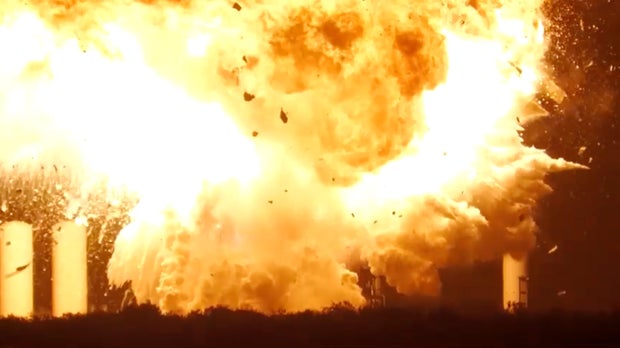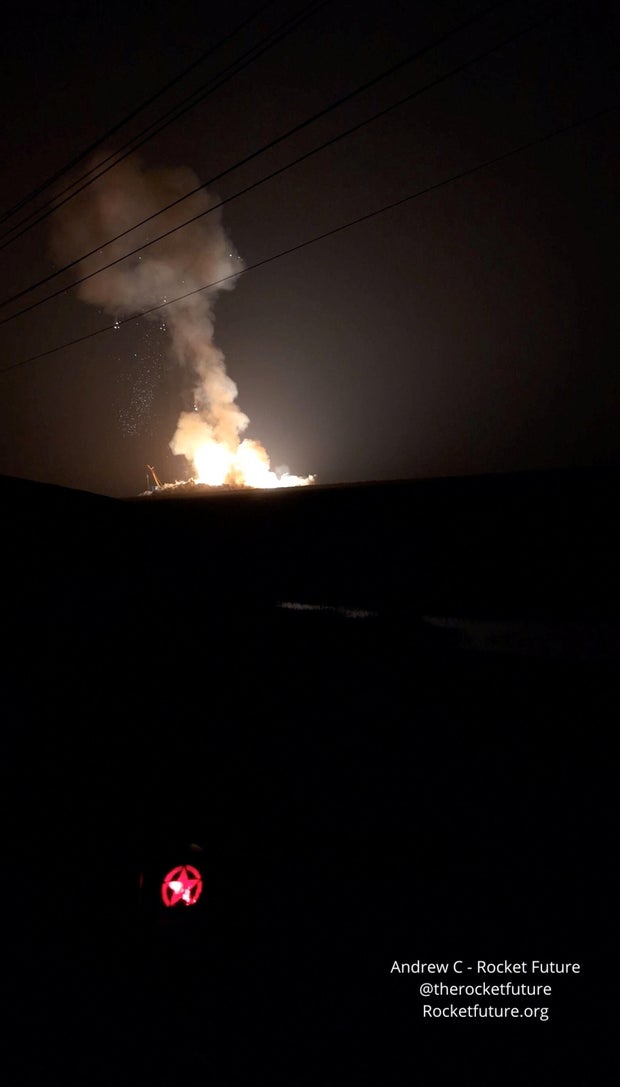The dramatic explosion of a SpaceX Starship upper stage rocket during a test at the company's Starbase facility on the Texas Gulf coast late Wednesday may have been triggered by the rupture of a high-pressure nitrogen tank, SpaceX founder Elon Musk said Thursday.
The sudden explosion, fueled by ignition of methane propellant, created a huge fireball, billowing clouds of smoke and brilliant arcs of flaming debris shooting out like burning chunks of lava in a volcanic eruption.
 This image from video shows a SpaceX Starship upper stage exploding at the Starbase facility on the Texas Gulf Coast late Wednesday, June 18, 2025.
TheRocketFuture via X / Reuters
This image from video shows a SpaceX Starship upper stage exploding at the Starbase facility on the Texas Gulf Coast late Wednesday, June 18, 2025.
TheRocketFuture via X / Reuters
The blast was reminiscent of the sudden explosion of a SpaceX Falcon 9 rocket during fueling at Cape Canaveral in August 2016 that destroyed an Israeli communications satellite. The Falcon 9 failure was blamed on the rupture of a high-pressure helium tank, known as a carbon overwrap pressure vessel, or COPV.
But the company said there is "no commonality" between the Falcon COPVs and those used in the Starship.
"Preliminary data suggests that a nitrogen COPV in the payload bay failed below its proof pressure," Musk said of the latest mishap on his social media platform X. "If further investigation confirms that this is what happened, it is the first time ever for this design."
The Starship upper stage exploded during the final stages of a countdown expected to end with a test firing of the rocket's six methane-powered Raptor engines on a test stand at the Starbase manufacturing facility. A single-engine test firing was carried out earlier this week.
Such "hotfire" tests are a normal precursor to actual flights, allowing engineers to verify upgrades and overall performance prior to committing the rocket to launch. A successful test Wednesday would have helped pave the way to launch atop a Super Heavy booster around the end of the month for the program's 10th "integrated flight test."
But the test did not go well. Video from LabPadre, a company that monitors SpaceX activities at Starbase, showed the Starship suddenly exploding in a huge fireball just after 11 p.m. CDT, 10 to 15 minutes before the anticipated engine test firing.
The video showed what appeared to be two major explosions, the first detonation near the nose of the rocket followed a moment later by a second eruption of flame and debris on the left side of the spacecraft. The test stand disappeared in a billowing orange fireball that rose into the overnight sky like a bomb blast.
 Flames rise as a SpaceX rocket explodes ahead of an engine test at the company's Starbase facility in Texas, June 18, 2025, in this screengrab obtained from a social media video.
TheRocketFuture via X / Reuters
Flames rise as a SpaceX rocket explodes ahead of an engine test at the company's Starbase facility in Texas, June 18, 2025, in this screengrab obtained from a social media video.
TheRocketFuture via X / Reuters
The Starship was being filled with a full load of liquid oxygen and a partial load of high-energy methane fuel when the detonations occurred. Ninety minutes after the initial blast, fires were still burning at the test site, where cryogenic testing and hotfires are typically conducted.
"On Wednesday, June 18 at approximately 11 p.m. CT, the Starship preparing for the tenth flight test experienced a major anomaly while on a test stand at Starbase," SpaceX said in a statement on X.
"A safety clear area around the site was maintained throughout the operation and all personnel are safe and accounted for. Our Starbase team is actively working to safe the test site and the immediate surrounding area in conjunction with local officials.
"There are no hazards to residents in surrounding communities, and we ask that individuals do not attempt to approach the area."
What impact the explosion might have had on the infrastructure at the test sight was not immediately known.
SpaceX has launched nine Super Heavy-Starship test flights since April 2023. The first three flights ended with explosions or breakups that destroyed both stages.
The fourth, fifth and sixth test flights were mostly successful, but two of the three most recent flights ended with Starship explosions before the spacecraft could reach its planned sub-orbital trajectory. During the third, most recent flight on May 27, the Starship reached its planned trajectory, but then spun out of control and broke up when it fell back into the atmosphere.
NASA is counting on the giant rocket to launch a Starship variant to the moon that will carry astronauts to a landing near the lunar south pole in the next two or three years.
It will not be easy.
To get the Human Landing System — HLS — Starship variant to the moon, SpaceX will need to launch multiple Super Heavy-Starships to Earth orbit in rapid-fire fashion where they will have to autonomously dock, transfer excess propellants to a "depot" Starship, undock, and return to Earth.
The HLS then would rendezvous and dock with the depot, reload its tanks and head for the moon to await the arrival of the Artemis astronauts aboard a Lockheed Martin-built Orion crew capsule.
SpaceX has not said how many refueling flights might be necessary. But given that both the lander and tanker Starships will use up most of their propellant just getting into orbit, some independent observers estimate as many as 10 to 20 launches will be needed to gas up the lander for the flight to the moon.
NASA officials have said the number likely will be in the "high teens."
It's not known what might happen if one of those refueling flights suffers a catastrophic failure, but it's difficult to imagine launches would continue without first finding out what went wrong and fixing it.
Along with mastering autonomous transfer of thousands of gallons of super-cold liquid oxygen and hydrogen while in space — a task never attempted at this scale — SpaceX will need to develop a reliable system to keep those propellants cold enough in the glare of the sun to minimize the amount that will boil off and be vented out to space.
No such technology has yet been tested in the space environment.
The need to launch multiple Super Heavy-Starships, the requirement to perfect the autonomous transfer of cryogenic propellants in space and new technology to keep the liquid methane and oxygen from warming and wasting away add up to a complex mission architecture with little margin for error under the current schedule.
The latest mishap renews concern in some quarters about SpaceX's ability to get all of that done in just two to three years. But SpaceX has proven skeptics wrong before and NASA continues to express support for the company and the path forward to the Artemis 3 lumar landing mission.
"Testing is a critical part of a development program, and we have confidence SpaceX will investigate every aspect of what went wrong to fix the issue," the agency said in a statement.
While pointing out that the moon lander planned for its Artemis program is different from the developmental Starship currently being tested, the agency added that "NASA fully supports SpaceX as the company prepares Starship for future missions."
"We look forward to the company delivering their Starship Human Landing System for NASA's Artemis 3 mission."
William Harwood








